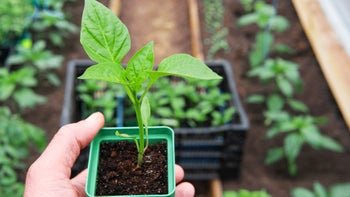
Stock up on These 12 Long-Lasting Vegetables That Stay Fresh for Weeks
Key takeaways:
Fresh produce is one of the most frequently wasted food items in U.S. homes.
Storing vegetables properly will help extend their shelf life.
Keeping a variety of long-lasting vegetables on hand is one way to make sure you always have vegetables to eat.
Table of contents

Eating vegetables is a key part of a balanced diet. However, if you find it difficult to keep fresh vegetables from going bad before you get a chance to eat them, you aren’t alone. TheDepartment of Agriculture (USDA) estimates that up to one-third of all food available for purchase in the United States is wasted. Unfortunately, fresh produce is one of the main types of food that winds up in our landfills.
Stocking up on vegetables with a long shelf life and learning how to store them properly helps to minimize food waste. It also means you’ll be more likely to have vegetables at home to use in nutritious meals.
Why shop for vegetables with a long shelf life?
Vegetables are nutrient-rich foods, and eating a variety of them is important for overall health. But less than 12% of people in the U.S. eat the recommended servings of vegetables daily. One way to make sure you’re eating enough vegetables is to keep a variety of longer-lasting items on hand. Buying long-lasting vegetables also helps with grocery affordability.
Vegetables that last the longest
Fresh produce is highly perishable. This means that if it’s not stored properly, it can ripen or spoil quickly. Generally, root vegetables like potatoes, carrots, and winter squash have a longer shelf life. Leafy greens and tender vegetables like tomatoes, cucumbers, eggplant, and broccoli have a shorter shelf life.
The factors that have the biggest impact on vegetables’ ripening processes are:
Moisture: Some vegetables are sensitive to moisture, which can affect how quickly they spoil. Vegetables that prefer dry conditions include potatoes, onions, garlic, and winter squash. Other vegetables need humidity to stay fresh. Leafy greens, broccoli, cauliflower and cabbage tend to do well in humidity.
Proximity to other produce: Some vegetables, such as peppers and tomatoes, give off a gas called ethylene. Other vegetables can be sensitive to ethylene, and may ripen quickly if stored nearby. This includes potatoes, onions, cucumbers, lettuce, and carrots.
Read more like this
Explore these related articles, suggested for readers like you.
Below are some examples of long-lasting vegetables, and how to store them at home. (We’ve also included frozen and canned versions, which are long-lasting as well.)
| Vegetable | Shelf life | Storage conditions | |
|---|---|---|---|
| Where to store | What container to use | ||
| Winter squash | 1-6 months | Cool and dry area | Loose with no covering to allow air to circulate |
| Cabbage | 3-4 weeks months | Crisper drawer in the refrigerator | Plastic bag to keep moisture in |
| Beets | 3-5 months | Crisper drawer (after removing green tops) | Plastic bag with holes in it |
| Garlic | 3-5 months | Cool, dry, and dark area | Mesh bag or basket to allow air to circulate |
| Potatoes | 1-6 months | Cool, dark area and away from heat sources | Mesh bag or basket, away from garlic and onions |
| Sweet potatoes | 2-4 months | Cool, dark area and away from heat sources | Mesh bag or basket, away from garlic and onions |
| Carrots | 4-5 months | Crisper drawer (after removing green tops) | Plastic bag with holes in it |
| Pumpkin | 2-3 months | Cool, dark, and dry area | Loose and uncovered to allow air to circulate |
| Onions | 2-3 months | Cool, dark, well-ventilated place or refrigerator | Mesh bag or basket to allow air to circulate |
| Celeriac (Celery root) | 3-4 months | Crisper drawer | Tightly sealed plastic bag |
| Rutabagas | 2-4 months | Crisper drawer | Plastic bag with holes in it |
| Winter radishes | 2-4 months weeks | Crisper drawer (after removing green tops) | Plastic bag with holes in it |
| Frozen vegetables | 8-12 months | Freezer (avoid storing in the door, if possible) | Sealed tightly in a plastic bag or container to avoid freezer burn |
| Canned vegetables | 1-1½ years for high-acid vegetables like tomatoes, 2-5 years for other vegetables | Cool, dry pantry; avoid moisture and hot or very cold temperatures | Don’t use cans that are dented, bulging, rusted, or leaking; these may be spoiled and could contain a toxin that can lead to food poisoning. |
Storage tips to keep your vegetables fresh longer
Several factors determine how long fresh produce will last, including how it’s stored. Storing vegetables properly will also ensure you get the maximum nutrition from what you buy.
As shown in the table above, some long-lasting vegetables — like potatoes, garlic, and winter squash — fare well in a cool, dark, and dry area. A basement or garage that’s protected from critters will often work well.
Other long-lasting vegetables require cooler temperatures and humidity to stay fresh. The crisper drawer of your refrigerator is ideal for vegetables like beets, carrots, rutabagas, and celeriac (celery root).
Another helpful tip is to trim the green tops off carrots, beets, and radishes before storing them. And then keep them in a plastic bag with holes in it. This allows air to circulate, which will prevent spoilage.
How long do veggies last in the fridge?
Some vegetables’ shelf life can be extended with refrigeration. The length of time for refrigeration depends on the vegetable, where in the fridge it is stored, and the container or wrapping. For most vegetables that need refrigeration, the crisper drawer is the best place for storage. It’s higher in humidity than the rest of the fridge.
Vegetables that do well in the refrigerator include:
Asparagus
Brussels sprouts, broccoli, and cauliflower
Beets
Carrots
Cucumbers
Leafy greens
Peppers
Summer squash
Other vegetables are better stored at room temperature in dry conditions. These include:
Garlic
Onions
Potatoes
Pumpkin
Tomatoes
Winter squash
How long can vegetables last in the freezer?
According to the National Center for Home Food Preservation, packaged frozen vegetables can last in the freezer for 8 to 12 months. These vegetables should be stored in the interior of the freezer in an air-tight, sealed bag or container. Storing frozen vegetables in the door of the freezer is less effective since the temperature there varies.
Frozen vegetables are often thought to be less nutritious than fresh vegetables, but that’s not true. An advantage of commercially frozen vegetables is that they’re packed within hours of harvest, which preserves most of their nutrients. Fresh vegetables, on the other hand, may take days to get to the store for sale and then may sit in your refrigerator or pantry for even longer. The longer these vegetables are exposed to air and light, the more chance there is for nutrients to be lost. Freezing is an excellent way to maximize vegetables’ nutritional value.
How to store vegetables long-term without refrigeration?
As mentioned above, many longer-lasting vegetables fare well when stored in a cool, dry, and dark place in your house such as a garage, shady screened-in porch, or basement. People used those old root cellars for a reason!
If those spaces aren’t options, vegetables can always be stored on the counter. Just try to keep them away from the stove and areas with high humidity if possible.
Canned vegetables are also a great way to store vegetables that don’t need refrigeration. Like frozen vegetables, canned vegetables are packed within hours of harvesting, which helps preserve many of their nutrients. Canned tomatoes often taste better than fresh tomatoes. And canned corn, artichokes, beans, and beets can be added to salads or soups.
Canned foods can be high in sodium, though, so look for “no salt added” or low-sodium versions. If you want to get the most nutrition and least amount of added salt from your canned vegetables, skip the veggies that are packed in sauces or those with seasonings added.
The bottom line
Vegetables are an important part of a healthy and balanced diet, and most people in the U.S. aren’t eating enough of them. Keeping a variety of long-lasting vegetables on hand and stored properly will help with meal planning and ensure you always have vegetables on hand for meals.
Why trust our experts?



References
AskUSDA. (2023). How long can you keep canned goods? U.S. Department of Agriculture.
Buzby, J. C., et al. (2014). The estimated amount, value, and calories of postharvest food losses at the retail and consumer levels in the United States. Economic Research Service.
Cornell Cooperative Extension of Chemung County. (2004). Storage guidelines for fruits & vegetables.
Fronk, L. (2022). Prevent rot of winter squash in storage. PennState Extension.
Harris, L. J. (2016). Garlic: Safe methods to store, preserve, and enjoy. ANR Publication.
Lee, S. H., et al. (2022). Adults meeting fruit and vegetable intake recommendations — United States, 2019. Morbidity and Mortality Weekly Report (MMWR).
McGavin, J. (2023). What is celeriac? The Spruce Eats.
MyPlate. (n.d.). Vegetables. U.S. Department of Agriculture.
National Center for Home Food Preservation. (n.d.). How long can I store frozen food. University of Georgia.
Nichols, J. (2014). Refrigerator humidity effects on produce quality. Michigan State University Extension.
University of Maine. (2020). How do I store carrots long term in my basement?
Venema, C. (2023). Michigan Fresh: Using, storing, and preserving sweet potatoes (HNI26). Michigan State University Extension Michigan Fresh.
Voss, R. E., et al. (n.d.). Proper environment for potato storage. The University of California Vegetable Research and Information Center.





























